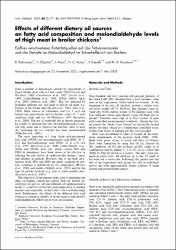Effects of different dietary oil sources on fatty acid composition and malondialdehyde levels of thigh meat in broiler chickens

Göster/
Erişim
info:eu-repo/semantics/openAccessTarih
2004Yazar
Kahraman, RecepÖzpınar, Haydar
Abaş, İsmail
Kutay, Halil Can
Eseceli, Hüseyin
Grashorn, Michael
Üst veri
Tüm öğe kaydını gösterÖzet
The aim of the experiment was to determine the effect of feeding various fat sources (fish oil, linseed oil, sunflower oil and soy oil) and different oil levels (2, 4 and 8%) on the fatty acid composition of chicken muscles and, to raise the content of long chain n-3 PUFA (EPA and DHA) to decrease the n-6/n-3 ratio in broiler carcasses. Furthermore, the effects of the different fatty acid sources on oxidation stability of broiler meat as indicated by malondial-dehyte (MDA) levels should be investigated.Nine hundred and sixty one-day-old unsexed chickens of the breed Cobb-500 were used this experiment, which lasted for 6 weeks. The chickens were divided into twelve dietary groups, 80 chickens in each, with four replicates (20 birds per replicate). Birds were given access to water and diets ad libitum that were formulated adding 2, 4 and 8% oil to a basal diet. Four dietary fat sources or combinations were applied: 1/1 fish oil (FO; diets A1, A2, A3); 2/3 FO + 1/3 linseed oil (LO; diets B1, B2, B3); 1/3 FO + 1/3 LO + 1/3 sunflower oil (SFO; diet C1, C2, C3); and 1/1 soy oil (SO; diets D1, D2, D3) were used.Fat source influenced lipid composition of thigh meat more than level of fat (2, 4 and 8%). According to the fat source added to the diet at the 21st day (diet A, B and C) and at the 42 nd day (A, B and D), significant differences of thigh meat fatty acid levels were observed (p < 0.05). Thigh meat from broiler groups fed with 8% oil (A3, B3, C3 and D3) showed a different fatty acid profile to the other oil levels (2 and 4%).Broilers fed with fish oil (A, B and C) had statistically higher EPA and DHA levels in thigh meat (p < 0.05) than broilers fed with soy oil (Diet D). Also, thigh meat of the soybean oil fed group (Diet D) showed a high-level n6 group fatty acid and the fish oil group's thigh meat showed high-level of n-3 fatty acids. The n-6/n-3 ratio was lowest for fish oil (p < 0.05) and the PUFA level changed depending on the type of oil and dietary level.The MDA level in the thigh meat was more affected by the dietary fatty acid source than by the level of fat. MDA level in thigh meat was increased (p < 0.05) with the increasing of the percentage of the dietary oil.The results of the current study indicate that feeding a diet containing an oil source leading to a desired fatty acid composition of the resulting tissue might customize the fatty acid profiles of broiler tissues. But, using fish oil and vegetable oil rich in long chain unsaturated fatty acids in broiler diets may result in an increased fatty acid oxidation in muscle tissues.

















